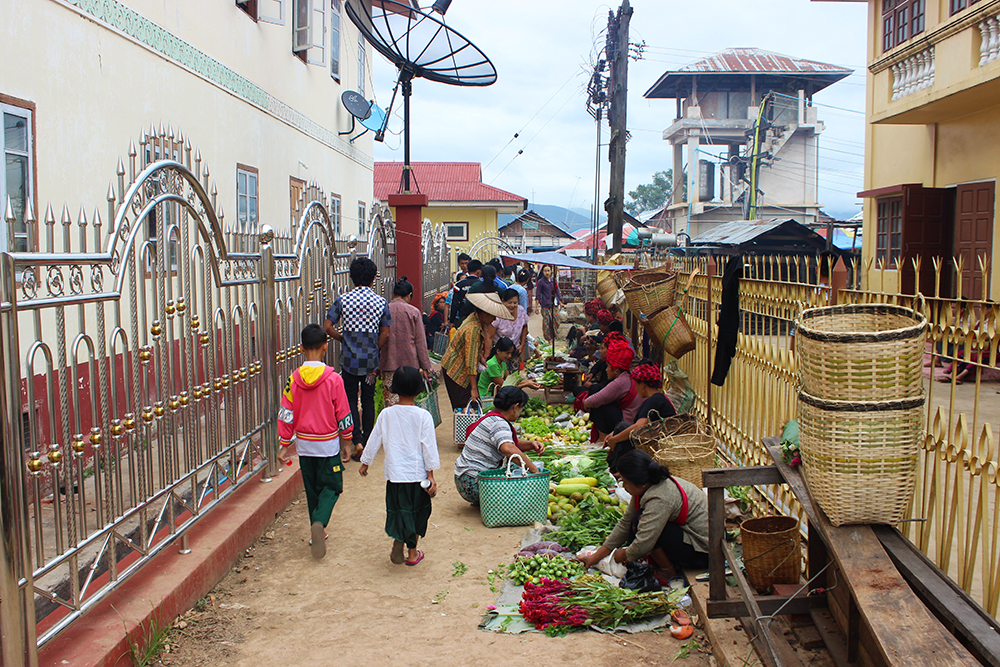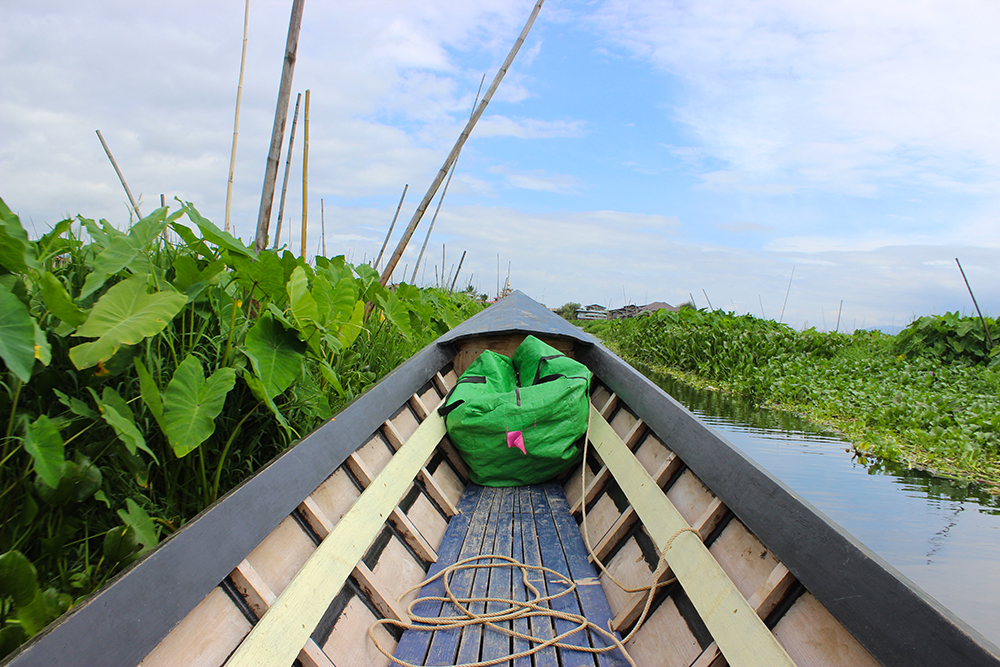On Inle Lake
The man's mouth dripped red, like he'd been feasting on the flesh of the living. He came toward me with a zombie's gait. His unnatural tallness was compressed into angles: bent elbows, tilted back, shoulders sloped forward until his stubbled face pushed toward mine. “Where are you from?” he asked with a bloody smile.
“Canada,” I lied. Every conversation in Myanmar started with, “Where are you from?” They all ended the same way too: “No thanks, I don’t want to buy anything.”
The zombie seemed to believe my fib. He nodded and spat a crimson gob onto the dirt road. All the men in dusty Nyaungshwe chewed betel leaves. They were used to wrap a tobacco substitute that had a rich red color, which gave addicts their man-eater smiles. The ground looked like a abattoir.
“Canada," he said. "Big country.”
“And cold,” I agreed cheerfully, and decided to expedite things. “You have a boat?”
“Yes. Very good boat," he replied. "You want a tour?”
I exchanged looks with Sam. He shrugged.
“Maybe tomorrow,” I told the zombie and moved on down the street. He followed a few paces, then fell back. Within seconds, a new form appeared at my elbow.
“Madam, where are you from?”
“Korea.” I beamed. Behind me, Sam choked down a laugh.
It continued like this all the way across town, intensifying as we neared the canal. Inle Lake is one of the Big Four tourist sites in Myanmar,* and every man in Nyaungshwe apparently worked in the boat business. I impersonated a German, an Australian, and briefly convinced one guide I hailed from a small vineyard outside of Lyon. I felt bad about the subterfuge, but it was the only way to have the same unwanted conversation over and over again without going nuts.
Sam and I paused on the bridge, looking down at the boats tethered to the shore. They were stretched-out canoes with bows rising several feet out of the water. Each sported an outboard motor, the better to cart around beefy tourists.
“Hey there. Where ya from?”
We turned to find a young guy about as tall as my shoulder. He had a snub-nose and the cocky face of a class clown. His smile was clean, white, and savvy. No betel leaves.
“The USA,” I told him. “Where are you from?”
“Me? I’m from here. A small village on the lake. That way.” He pointed down the canal, then leaned against the bridge railing. “You want a boat?”
I looked at Sam. He looked at me.
“How much?” I asked.
We met our guide on the pier at six the next morning. It looked like rain, and a breeze kept ruffling up the map he was trying to show us.
“We will start here,” he pointed to Phaung Daw Oo Pagoda at the opposite end of the lake. I followed his finger across our itinerary. Market, temple, silversmith, fishermen’s village, weaver, cigar maker, floating gardens…
“Long-neck women are here,” he ran a hand over his throat to make sure I understood. Inle's attractions included a group of Karen women who bound their throats in metal rings, compressing the chest and shoulders so their necks looked unnaturally long. It was a rare photo opportunity, since the Karen people generally either lived in the restricted, war-torn Kayah province, or as refugees in northern Thailand.
I’d wanted to see long-necked women since I was a kid paging through my parents’ National Geographics. But I'd heard a rumor that the government carted them in as tourist attractions. (Thailand used them similarly.) I wasn't sure this was true, but I couldn't shake my discomfort. It would feel too much like a zoo exhibit. Our guide seemed to guess our hesitation.
“We don’t have to go there,” he told us, rolling up the map. “Your choice.”
“We can choose anything, right?” Sam asked. We’d heard that several tour stops were enforced shopping. Our packs were too full and our wallets too empty for a buying spree.
“Yes. You choose.” Our guide smiled grandly, and herded us into the boat.
Locals sat in the sloping bottom, but tourists got canvas folding chairs and umbrellas. Our guide and driver ran along the edges of the craft like barefoot tightrope walkers, arranging the chairs and life vests, tying ropes. Then they helped us clunky tourists board--slowly, slooowly--like we were their aged, fragile grandmothers.
As we emptied out of the canal into the lake proper, we found three fishermen waiting for us. They crouched in tiny wooden boats next to the giant, woven bell jars they used as nets. As we slowed, one man stood and braced himself on his oar. He raised his net into the air and balanced like an acrobat. It was a classic picture of the famous one-legged oarsmen of Inle.
Then he waited. And waited. Until we caught on and took the photo.
The man dropped his pose and grabbed onto the side of out boat. He thrust a fish in Sam’s face. Startled, Sam snapped another picture. Then the fisherman-turned-model stared expectantly until we searched our pockets for a tip.
As we sped across slate grey water, I watched rain tumble down the mountains on our left while the sun rose on our right. The wind was up, whipped further by the ride. For the first time in Myanmar, I felt cold.
Our driver pulled up before the golden spire of Phaung Daw Oo. We skirted barefoot around the temple to the market beyond.
After a trip around the market, we returned to the lake. Our guide sat behind us, tapping on his smartphone as he asked where we wanted to go. I realized he was texting the shops, giving them a heads-up on our route.
Did we want to see silversmiths? Not really. Lotus weavers? Sure, why not? A girl met us on the wooden steps leading from the water to the shop. She gave us a brief tour. Here's where they pulled fibers from the lotus stems. Here they spun it into thread. The looms shifted and clacked, weaving lotus, silk, and cotton into scarves and longyis, the traditional long skirts worn by men and women. The tour ended in the gift shop.
Did we want to visit the jumping cat monastery? A definite yes. According to our guidebook, monks there had trained cats to leap through hoops and perform acrobatics.
"That was maybe four years ago," our guide warned. "Now the cats are lazy."
We also said yes to the cigar makers. Three women sat cross-legged rolling cheroots out of tobacco and star anise. They used corn husk filters, palm-leaf cigar papers. Would we like to try one?
As Sam smoked, I chatted with the round-faced young woman who was showing us the shop. She told me she'd just finished university.
“Oh, what did you study?” I asked.
“Geography.”
“Wow! So what will you do now that you’ve finished?”
She looked at me oddly. “Work here.”
“Oh," I tried to cover, "Of course.” It wasn’t the first time I’d been caught off-guard by this. One waiter in Bagan had told us all about the degree he was pursuing in archaeology. His dream had been to become a tour guide. Everyone we met seemed to have been to university. There just wasn’t much for them afterwards outside of tourism.
Back in the boat, we said a reluctant no to the long-necked women, so the driver steered us into the floating gardens. As we sped past cucumber and tomato plants, I asked our guide about himself. He had studied economics in university. There weren’t any jobs around Inle, though, except tourism and farming. He pointed out men harvesting seaweed to fertilize the crops. Because of the climate they were able to harvest several times a year. There was always work for farmers.
“That’s good,” I said, thinking of continuous employment.
“But they can never take a holiday,” our guide pointed out. That’s why he’d gone into boat tours. Most of the men in Nyaungshwe were guides and drivers, at least part-time.
I regretted my impatient teasing of the boatmen. It was low season, tourist-wise, and willing guides far outnumbered potential fares. In fact, it seemed like tourists were contributing factors to many of Inle's problems. All the accessible jobs involved catering to Western visitors. Why pursue geography or economics when the real money was in babysitting foreigners?
Tourists were hardly Myanmar's biggest problem. Still, I understood why they helped us in and out of the boat with such exaggerated caution. We were a commodity--precious and temperamental.
Back at the Nyaungshwe pier, our guide assisted us onto dry land. "See you again next time," he grinned, pocketing his tip. He waived goodbye, then slid over to another sunburnt Western couple, looking over the boats from the pier.
"Hey, where ya from?" I heard him ask as we climbed back up the red-spattered road toward town. At Inle Lake, a husker's job was never done.
-Erin
*Yangon, Bagan, Inle Lake, and Mandalay comprise the main tourist trail in Myanmar. These areas are accessible on a standard tourist visa, but you'll need permits to visit many other regions of the country.

















